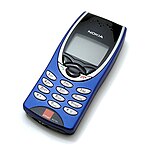This article needs additional citations for verification. (January 2017) |
 | |
| Manufacturer | Nokia |
|---|---|
| First released | November 1999 |
| Discontinued | Yes |
| Predecessor | Nokia 8810 (8210/8260/8290) Nokia 8860 (8250/8270) |
| Successor | Nokia 2100 (8270) Nokia 3610 (8250) Nokia 6500 (8265i) Nokia 6510 (8265) Nokia 6590 (8280) Nokia 6590i (8280i) Nokia 8210 4G (revival) Nokia 8310 (8210) Nokia 8390 (8290) |
| Related | Nokia 7110 Nokia 8850 |
| Compatible networks | GSM 900/1800/1900 (8210/8250/8290) TDMA 850/1900 AMPS 850 (8260/8265/8265i) CDMA 1900 (8270/8277) |
| Form factor | Candybar |
| Dimensions | 101.5 mm × 44.5 mm × 17.4 mm (4.00 in × 1.75 in × 0.69 in) |
| Weight | 79 g (2.8 oz) |
| Operating system | Series 20 |
| Storage | up to 250 contacts |
| Battery | 650 mAh Li-Ion (BLB-2), replaceable |
| Display | Monochrome |
| Sound | Headset connector |
| Connectivity | Infrared (IrDA) |
| Data inputs | Keypad |
| Other | Xpress-on covers |

Nokia 8210 is a mobile phone by Nokia, announced on 8 October 1999 in Paris. At the time, it was the smallest, lightest Nokia mobile phone on the market. [1] A primary selling point of its design was its removable cover that allowed for easy customization. Six differently coloured Xpress-on covers are available, as well as many third-party ones.[2]
Nokia 8210 uses the GSM 900/1800 band, supports the Extended GSM 900 band (EGSM), and can automatically switch between bands.